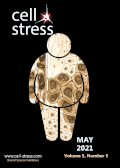Table of contents
Volume 5, Issue 5, pp. 55 - 75, May 2021
Cover: This month in
Cell Stress: Obesity-related cancers. Backdrop image: Growing cancer cells spreading to other parts of the body through the circulatory system. Credit: Darryl Leja, National Human Genome Research Institute, NIH. Public domain image modified by
Cell Stress. The cover is published under the
CC BY 4.0 license.
Enlarge issue cover
Cellular mechanisms linking cancers to obesity
Xiao-Zheng Liu, Line Pedersen and Nils Halberg
Reviews |
page 55-72 | 10.15698/cst2021.05.248 | Full text | PDF |
Abstract
Obesity is epidemiologically linked to 13 forms of cancer. The local and systemic obese environment is complex and likely affect tumors through multiple avenues. This includes modulation of cancer cell phenotypes and the composition of the tumor microenvironment. A molecular understanding of how obesity links to cancer holds promise for identifying candidate genes for targeted therapy for obese cancer patient. Herein, we review both the cell-autonomous and non-cell-autonomous mechanisms linking obesity and cancer as well as provide an overview of the mouse model systems applied to study this.
Coping with the calcium overload caused by cell injury: ER to the rescue
Goutam Chandra, Davi A. G. Mázala and Jyoti K. Jaiswal
Microreviews |
page 73-75 | 10.15698/cst2021.05.249 | Full text | PDF |
Abstract
Cells maintain their cytosolic calcium (Ca2+) in nanomolar range and use controlled increase in Ca2+ for intracellular signaling. With the extracellular Ca2+ in the millimolar range, there is a steep Ca2+ gradient across the plasma membrane (PM). Thus, injury that damages PM, leads to a cytosolic Ca2+ overload, which helps activate PM repair (PMR) response. However, in order to survive, the cells must cope with the Ca2+ overload. In a recent study (Chandra et al. J Cell Biol,doi: 10.1083/jcb.202006035) we have examined how cells cope with injury-induced cytosolic Ca2+ overload. By monitoring Ca2+ dynamics in the cytosol and endoplasmic reticulum (ER), we found that PM injury-triggered increase in cytosolic Ca2+ is taken up by the ER. Pharmacological inhibition of ER Ca2+ uptake interferes with this process and compromises the repair ability of the injured cells. Muscle cells from patients and mouse model for the muscular dystrophy showed that lack of Anoctamin 5 (ANO5)/Transmembrane protein 16E (TMEM16E), an ER-resident putative Ca2+-activated chloride channel (CaCC), are poor at coping with cytosolic Ca2+ overload. Pharmacological inhibition of CaCC and lack of ANO5, both prevent Ca2+ uptake into ER. These studies identify a requirement of Cl– uptake by the ER in sequestering injury-triggered cytosolic Ca2+ increase in the ER. Further, these studies show that ER helps injured cells cope with Ca2+ overload during PMR, lack of which contributes to muscular dystrophy due to mutations in the ANO5 protein.



